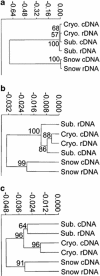Molecular evidence for an active endogenous microbiome beneath glacial ice
- PMID: 23486249
- PMCID: PMC3695297
- DOI: 10.1038/ismej.2013.31
Molecular evidence for an active endogenous microbiome beneath glacial ice
Abstract
Geologic, chemical and isotopic evidence indicate that Earth has experienced numerous intervals of widespread glaciation throughout its history, with roughly 11% of present day Earth's land surface covered in ice. Despite the pervasive nature of glacial ice both today and in Earth's past and the potential contribution of these systems to global biogeochemical cycles, the composition and phylogenetic structure of an active microbial community in subglacial systems has yet to be described. Here, using RNA-based approaches, we demonstrate the presence of active and endogenous archaeal, bacterial and eukaryal assemblages in cold (0-1 °C) subglacial sediments sampled from Robertson Glacier, Alberta, Canada. Patterns in the phylogenetic structure and composition of subglacial sediment small subunit (SSU) ribosomal RNA (rRNA) assemblages indicate greater diversity and evenness than in glacial surface environments, possibly due to facilitative or competitive interactions among populations in the subglacial environment. The combination of phylogenetically more even and more diverse assemblages in the subglacial environment suggests minimal niche overlap and optimization to capture a wider spectrum of the limited nutrients and chemical energy made available from weathering of bedrock minerals. The prevalence of SSU rRNA affiliated with lithoautotrophic bacteria, autotrophic methane producing archaea and heterotrophic eukarya in the subglacial environment is consistent with this hypothesis and suggests an active contribution to the global carbon cycle. Collectively, our findings demonstrate that subglacial environments harbor endogenous active ecosystems that have the potential to impact global biogeochemical cycles over extended periods of time.
Figures



Similar articles
-
Diversity, abundance, and potential activity of nitrifying and nitrate-reducing microbial assemblages in a subglacial ecosystem.Appl Environ Microbiol. 2011 Jul;77(14):4778-87. doi: 10.1128/AEM.00376-11. Epub 2011 May 27. Appl Environ Microbiol. 2011. PMID: 21622799 Free PMC article.
-
Microbial diversity of an Antarctic subglacial community and high-resolution replicate sampling inform hydrological connectivity in a polar desert.Environ Microbiol. 2019 Jul;21(7):2290-2306. doi: 10.1111/1462-2920.14607. Epub 2019 Apr 16. Environ Microbiol. 2019. PMID: 30927377
-
Phylogenetic diversity and metabolic potential revealed in a glacier ice metagenome.Appl Environ Microbiol. 2009 Dec;75(23):7519-26. doi: 10.1128/AEM.00946-09. Epub 2009 Oct 2. Appl Environ Microbiol. 2009. PMID: 19801459 Free PMC article.
-
Subglacial Lake Whillans microbial biogeochemistry: a synthesis of current knowledge.Philos Trans A Math Phys Eng Sci. 2016 Jan 28;374(2059):20140290. doi: 10.1098/rsta.2014.0290. Philos Trans A Math Phys Eng Sci. 2016. PMID: 26667908 Review.
-
Microbial ecology of mountain glacier ecosystems: biodiversity, ecological connections and implications of a warming climate.Environ Microbiol. 2017 Aug;19(8):2935-2948. doi: 10.1111/1462-2920.13766. Epub 2017 May 30. Environ Microbiol. 2017. PMID: 28419666 Review.
Cited by
-
Microbial genetic potential differs among cryospheric habitats of the Damma glacier.Microb Genom. 2024 Oct;10(10):001301. doi: 10.1099/mgen.0.001301. Microb Genom. 2024. PMID: 39351905 Free PMC article.
-
Anoxygenic Phototrophs Span Geochemical Gradients and Diverse Morphologies in Terrestrial Geothermal Springs.mSystems. 2019 Nov 5;4(6):e00498-19. doi: 10.1128/mSystems.00498-19. mSystems. 2019. PMID: 31690593 Free PMC article.
-
Mechanisms of Mineral Substrate Acquisition in a Thermoacidophile.Appl Environ Microbiol. 2018 May 31;84(12):e00334-18. doi: 10.1128/AEM.00334-18. Print 2018 Jun 15. Appl Environ Microbiol. 2018. PMID: 29625980 Free PMC article.
-
Microbial Community Structure and Metabolic Potential at the Initial Stage of Soil Development of the Glacial Forefields in Svalbard.Microb Ecol. 2023 Aug;86(2):933-946. doi: 10.1007/s00248-022-02116-3. Epub 2022 Oct 14. Microb Ecol. 2023. PMID: 36239777
-
Patterns in Microbial Assemblages Exported From the Meltwater of Arctic and Sub-Arctic Glaciers.Front Microbiol. 2020 Apr 15;11:669. doi: 10.3389/fmicb.2020.00669. eCollection 2020. Front Microbiol. 2020. PMID: 32351489 Free PMC article.
References
-
- Blomberg SP, Garland T, Ives AR. Testing for phylogenetic signal in comparative data: behavioral traits are more labile. Evolution. 2003;57:717–745. - PubMed
-
- Boyd ES, Cummings DE, Geesey GG. Mineralogy influences structure and diversity of bacterial communities associated with geological substrata in a pristine aquifer. Microb Ecol. 2007a;54:170–182. - PubMed
-
- Boyd ES, Skidmore M, Mitchell AC, Bakermans C, Peters JW. Methanogenesis in subglacial sediments. Environ Microbiol Rep. 2010;2:685–692. - PubMed
Publication types
MeSH terms
Substances
LinkOut - more resources
Full Text Sources
Other Literature Sources
Miscellaneous

